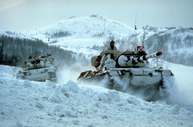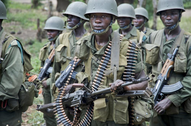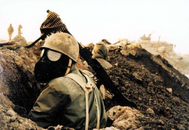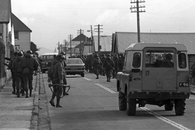Third Great War
| Third Great War | |||||||
|---|---|---|---|---|---|---|---|
| Part of the Great Wars | |||||||
| |||||||
| |||||||
| Belligerents | |||||||
|
(After 1977) |
(Until 1977) (Until 1980) Supported By N/A | ||||||
| Commanders and leaders | |||||||
| TBDCOMMANDERLIST |
| ||||||
| Casualties and losses | |||||||
|
Military Dead: TBD Civilians Dead: TBD Total Dead: TBD |
Military Dead: TBD Civilians Dead: TBD Total Dead: TBD | ||||||
|
Total Dead: TBD | |||||||
The Third Great War, often abbreviated as GWIII or GW3, was a global war that lasted from 1976 to 1983, involving countries from all continents except Lohicamia. The Third Great War involved all of the world's major powers, united into two opposing alliances: the Third Coalition (led by the Furbish Islands, Fluvannia, Greater Niagara, and Alaoyi) and the Communist Ascendancy (led by Gagium, Alanna, Pätschlàn, Inglaterra, and Seocheon). The participants threw the whole of their economies, industries, and sciences into a total war that blurred the line between civilian and military targets. Strategic bombing, indiscriminate artillery bombardment, and chemical weapons inflicted millions of civilian casualities.
The Third Great War was the deadliest conflict in human history; it resulted in over 100 million fatalities between military and civilian deaths. Tens of millions were killed due to starvation, genocide, and disease. As a result, tribunals of war criminals were conducted against Gagian, Inglaterran, and Alannan leaders. Gagium, along with parts of Inglaterra and Alanna, were occupied by Coalition forces.
The causes of the Third Great War are debated, but most historians agree that the unresolved conflict in the León Monarchy, tensions between Alaoyi and Inglaerra, the ineffectiveness of the Forum and Council of Nations, and the rise of hardline communist governments in many countries contributed to causing the war. The Third Great War is generally considered to have started when Inglaterra and Alanna invaded Alaoyi and Niagara's Antarctic and the Niagaran-owned Trans-Frigo canal. on 12 March 1976. The invasion of Alaoyi opened one of the largest land theaters of war in history. From early 1976 to mid 1977, Inglaterran and Alannan troops advanced deep into Alaoyian territory. However, the winter of 1976 provided Alaoyian troops with time to build up their defenses in the Diash mountains. Following a series of failed attacks by Ascendancy troops, including the Battle of Merileach (one of the bloodiest battles in history), turned the tide of the conflict. With Naossia joining the war and the arrival of Antarctic Expeditionary Force, Coalition forces in Galia managed to begin pushing the Ascendancy back. By the start of 1979, Coalition troops had begun advancing into Inglaterran territory and the capture of key ports in Alanna
The causes of World War II are debated, but contributing factors included the Second Italo-Ethiopian War, Spanish Civil War, Second Sino-Japanese War, Soviet–Japanese border conflicts, rise of fascism in Europe and rising European tensions since World War I. World War II is generally considered to have begun on 1 September 1939, when Nazi Germany, under Adolf Hitler, invaded Poland. The United Kingdom and France subsequently declared war on Germany on 3 September. Under the Molotov–Ribbentrop Pact of August 1939, Germany and the Soviet Union had partitioned Poland and marked out their "spheres of influence" across Finland, Estonia, Latvia, Lithuania and Romania. From late 1939 to early 1941, in a series of campaigns and treaties, Germany conquered or controlled much of continental Europe, and formed the Axis alliance with Italy and Japan (with other countries later). Following the onset of campaigns in North Africa and East Africa, and the fall of France in mid-1940, the war continued primarily between the European Axis powers and the British Empire, with war in the Balkans, the aerial Battle of Britain, the Blitz of the United Kingdom, and the Battle of the Atlantic. On 22 June 1941, Germany led the European Axis powers in an invasion of the Soviet Union, opening the Eastern Front, the largest land theatre of war in history.
Japan, which aimed to dominate Asia and the Pacific, was at war with the Republic of China by 1937. In December 1941, Japan attacked American and British territories with near-simultaneous offensives against Southeast Asia and the Central Pacific, including an attack on the US fleet at Pearl Harbor which resulted in the United States and United Kingdom declaring war against Japan. The European Axis powers declared war on the United States in solidarity. Japan soon captured much of the western Pacific, but its advances were halted in 1942 after losing the critical Battle of Midway; later, Germany and Italy were defeated in North Africa and at Stalingrad in the Soviet Union. Key setbacks in 1943—including a series of German defeats on the Eastern Front, the Allied invasions of Sicily and the Italian mainland, and Allied offensives in the Pacific—cost the Axis powers their initiative and forced them into strategic retreat on all fronts. In 1944, the Western Allies invaded German-occupied France, while the Soviet Union regained its territorial losses and turned towards Germany and its allies. During 1944 and 1945, Japan suffered reversals in mainland Asia, while the Allies crippled the Japanese Navy and captured key western Pacific islands.
The war in Europe concluded with the liberation of German-occupied territories and the invasion of Germany by the Western Allies and the Soviet Union, culminating in the Fall of Berlin to Soviet troops, Hitler's suicide, and the German unconditional surrender on 8 May 1945. Following the refusal of Japan to surrender on the terms of the Potsdam Declaration (issued 26 July 1945), the United States dropped the first atomic bombs on the Japanese cities of Hiroshima on 6 August and Nagasaki on 9 August. Faced with an imminent invasion of the Japanese archipelago, the possibility of additional atomic bombings, and the Soviet Union's declared entry into the war against Japan on the eve of invading Manchuria, Japan announced on 10 August its intention to surrender, signing a surrender document on 2 September 1945.
World War II changed the political alignment and social structure of the globe. The United Nations was established to foster international co-operation and prevent future conflicts,[1] with the victorious great powers—China, France, the Soviet Union, the United Kingdom, and the United States—becoming the permanent members of its Security Council. The Soviet Union and the United States emerged as rival superpowers, setting the stage for the nearly half-century-long Cold War. In the wake of European devastation, the influence of its great powers waned, triggering the decolonisation of Africa and Asia. Most countries whose industries had been damaged moved towards economic recovery and expansion. Political and economic integration, especially in Europe, began as an effort to forestall future hostilities, end pre-war enmities and forge a sense of common identity.







